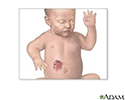Hemangioma
Infantile hemangioma; Cavernous hemangioma; Strawberry nevus; Birthmark - hemangioma
A hemangioma is an abnormal buildup of blood vessels in the skin or internal organs.
Causes
About one third of hemangiomas are present at birth. The rest appear in the first several months of life.
The hemangioma may be:
- In the top skin layers (capillary hemangioma)
- Deeper in the skin (cavernous hemangioma)
- A mixture of both layers of skin
- In an internal organ and not visible
Symptoms
Symptoms of a hemangioma are:
- A red to reddish-purple, raised growth on the skin
- A massive, raised, bluish lump with visible blood vessels
Most hemangiomas are on the head, neck, or extremities.
Exams and Tests
The health care provider will do a physical exam to diagnose a hemangioma. If the buildup of blood vessels is deep inside the body, a CT or MRI scan may be needed.
A hemangioma may occur with other rare conditions. Other tests to check for related problems may be done.
Treatment
The majority of small or uncomplicated hemangiomas may not need treatment. They often go away on their own and the appearance of the skin returns to normal. Sometimes, a laser may be used to remove the small blood vessels.
Taking beta-blocker medicines may also help reduce the size of a hemangioma.
Cavernous hemangiomas that involve the eyelid and block vision can be treated with lasers or steroid injections to shrink them. This allows vision to develop normally. Large cavernous hemangiomas or mixed hemangiomas may be treated with steroids, taken by mouth or injected into the hemangioma.
Outlook (Prognosis)
Small superficial hemangiomas will often disappear on their own. About one half go away by age 5, and almost all disappear by age 7.
Possible Complications
These complications can occur from a hemangioma:
- Bleeding (especially if the hemangioma is injured)
- Problems with breathing and eating
- Psychological problems, from skin appearance
- Secondary infections and sores
- Visible changes in the skin
- Vision problems
When to Contact a Medical Professional
All birthmarks, including hemangiomas, should be evaluated by your provider during a regular exam.
Hemangiomas of the eyelid that may cause problems with vision must be treated soon after birth. Hemangiomas that interfere with eating or breathing also need to be treated early.
Contact your provider if a hemangioma is bleeding or develops a sore.
Prevention
There is no known way to prevent hemangiomas.
References
Dinulos JGH. Vascular tumors and malformations. In: Dinulos JGH, ed. Habif's Clinical Dermatology. 7th ed. Philadelphia, PA: Elsevier; 2021:chap 23.
Martin KL. Vascular disorders. In: Kliegman RM, St. Geme JW, Blum NJ, Shah SS, Tasker RC, Wilson KM, eds. Nelson Textbook of Pediatrics. 21st ed. Philadelphia, PA: Elsevier; 2020:chap 669.
Patterson JW. Vascular tumors. In: Patterson JW, ed. Weedon's Skin Pathology. 5th ed. Philadelphia, PA: Elsevier Limited; 2021:chap 39.
Hemangioma - angiogram - illustration
Hemangioma - angiogram
illustration
Hemangioma excision - series
Presentation
Hemangioma on the face (nose) - illustration
Hemangioma on the face (nose)
illustration
Hemangioma excision - illustration
Hemangioma excision
illustration
Review Date: 11/30/2022
Reviewed By: Ramin Fathi, MD, FAAD, Director, Phoenix Surgical Dermatology Group, Phoenix, AZ. Also reviewed by David C. Dugdale, MD, Medical Director, Brenda Conaway, Editorial Director, and the A.D.A.M. Editorial team.












